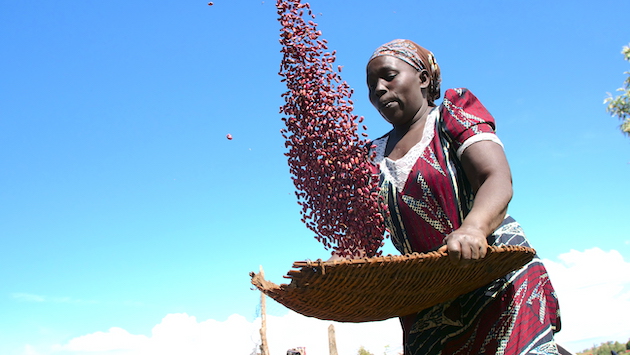Nov 22 (IPS) – In a groundbreaking development, indigenous farmer communities are poised to bring the spotlight onto food systems at the upcoming UN Climate Conference (COP28) in Dubai.
Recent research revealing that food systems contribute to roughly one-third of global greenhouse gas emissions has spurred a compelling call to action.
Furthermore, as one-third of the world’s food goes to waste, an alarming over 700 million people grapple with hunger. At the same time, a staggering 3 billion individuals cannot access a nutritious diet. This issue is poised to worsen due to the adverse effects of extreme weather events and biodiversity loss on global agriculture.
After years of relative neglect in global climate negotiations, food systems have finally taken center stage at COP28.
Estrella Penunia, the Secretary General of the Asian Farmers’ Association for Sustainable Rural Development (AFA), said at a conference held ahead of World Food Day that while approximately 4 percent of climate financing is allocated to agriculture, a mere 1.7 percent reaches family farmers.
“We want to play the role of climate stewards in our farms, fisheries, and forests because we know the solutions on how to transition to sustainable, inclusive, just, and healthy food systems to regenerative and agricultural approaches,” Penunia told the virtual press conference.
Under the leadership of the COP28 presidency, it is anticipated that world leaders will unite to endorse an unprecedented declaration acknowledging the undeniable connections between food systems, agriculture, and climate change at the World Climate Action Summit on December 1-2.
What’s more, the COP28 event will set a precedent by dedicating a thematic day to food systems on December 10. Expectations run high for farmers, businesses, civil society, and other stakeholders to deliver ambitious announcements and rallying calls to further advance the significance of food systems in the current year.
According to Penunia, governments, development partners, the private sector, and civil society organizations must unite to support indigenous farmers. She emphasized the need for favorable policies and programs to expand and enhance their work and for sufficient financing to be directed toward agriculture.
“Direct financing for small-scale family farmers is key to empowering their organizations and cooperatives as effective change agents. The aim is to enable millions of family farmers to directly contribute solutions,” said Penunia.
Stakeholders are concerned that the food systems agenda has been inadequately represented in global climate discussions, but there is now a growing recognition of the substantial impact of agricultural emissions, including methane and carbon dioxide, on the climate.
David Nabarro, the strategic director at the 4 SD Foundation, emphasized that while the contribution of agriculture and food to greenhouse gas emissions has been known for some time, there is now widespread recognition that it warrants serious attention. Moreover, climate change challenges have intensified over the past few years, with increasing reports from farmers about the near impossibility of dealing with its effects.
Nabarro, also a senior advisor to the COP28 Food Systems team, underscored the significance of the upcoming COP28 in Dubai. “It places the issue squarely on the table despite the difficulties involved and brings together various groups. World leaders understand the imperative of addressing all sources of emissions and working with diverse companies and countries to effect meaningful change.”
Gonzalo Munoz, a former high-level champion for COP25 and lead on the COP28 Non-State Actors Agenda for Food Systems on behalf of the UN Climate Champions, stressed the need to demonstrate a sense of urgency and the imperative of scaling up action.
“This call to action endorses the Emirates Declaration and backs its implementation, developed in consultation with non-state actors. Consequently, at COP28, there will be a launch of a non-state actor call to action aimed at transforming food systems for the benefit of people, nature, and climate,” said Gonzalo.
This initiative also underscores the critical need to respect and value the traditional knowledge held by indigenous people and the local knowledge possessed by farmers, fishers, and other food producers.
In the local context, respecting and valuing the traditional knowledge of indigenous peoples and local farmers, fishers, ranchers, and pastoralists is vital. it is equally important to engage women and youth in climate negotiations and other processes at all levels, as Rebecca Brooks, a high-level climate champion, emphasized.
“Strengthening the capacity of organizations representing these groups and providing appropriate resources, incentives, and technical support is essential,” Brooks, also the pillar lead for the non-state actors pillar of the COP28 Food Systems and Agriculture Agenda, told the press conference.
Dr Tim Benton, the Research Director of the Environment and Society Program at Chatham House, emphasized the pivotal role of transforming the food system in addressing the climate crisis, biodiversity loss, pollution, human health, and well-being.
He raised the question of how to make it profitable for farmers to adopt more sustainable, resilient practices without the pressures often stemming from globalized systems to maximize yield at any cost.
Benton also acknowledged the substantial challenges facing smallholder farmers in many parts of the global south, particularly in the middle latitudes.
“The challenges for smallholder farmers in many parts of the global south, and particularly the middle latitudes of the world, are huge,” he reiterated.
Regarding potential trade-offs, Benton recognized that there are real trade-offs, such as balancing biodiversity conservation, nutrition, farmer livelihoods, and greenhouse gas emissions. The complex task is to find solutions that address these trade-offs effectively.
IPS UN Bureau Report
Follow @IPSNewsUNBureau
Follow IPS News UN Bureau on Instagram
© Inter Press Service (2023) — All Rights ReservedOriginal source: Inter Press Service
Check out our Latest News and Follow us at Facebook
Original Source

